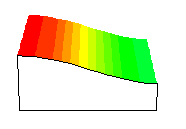Exercise 5: Tides.
Page 22

Tides which resemble the fisk tank model for the non-rotating earth can be observed on Earth in small shallow bays, which have dimensions that bring them into
resonance with one of the tidal constituents. Such bays are long and narrow, so the water can only move
along the axis of the bay and does not find the room to rotate around the edge; in other words, the rotation
of the earth cannot exert its influence on the tidal motion.
The most famous example is the Bay of Fundy on the Canadian Atlantic coast, where the tidal range (twice
the amplitude) at the inner end of the bay reaches 14 m.
There is one important difference between such small bays and our fish tank and table model. These bays are much too small for the tide generating force to exert any direct effect.
Instead, the forcing comes from the connection with the deep ocean. The oceanic tide forces water
movement into and out of the bay, which then comes into resonance. This means that the mouth of the bay
 represents a place of little vertical motion (0.5 m or less) but strong horizontal movement; in other words, it
has to be very close to a node. Tidal resonance in small bays is therefore similar to only one half of the fish
tank seen in the upper animation and takes the shape demonstrated in the second animation. Such tides in small bays are known as co-oscillation tides (the bay co-oscillates with the open ocean).
represents a place of little vertical motion (0.5 m or less) but strong horizontal movement; in other words, it
has to be very close to a node. Tidal resonance in small bays is therefore similar to only one half of the fish
tank seen in the upper animation and takes the shape demonstrated in the second animation. Such tides in small bays are known as co-oscillation tides (the bay co-oscillates with the open ocean).
The essential condition for large tides in inlets and bays is that the tidal wave has unrestricted access to
the area (and is enhanced by resonance). Regions with very restricted connection to the open ocean
cannot develop tides. This is the reason why mediterranean seas are essentially tide-free.
 © 2000 M. Tomczak
© 2000 M. Tomczak
contact address:
home page: http://www.es.flinders.edu.au/~mattom
web address of Exercises in Oceanography: http://www.es.flinders.edu.au/~mattom/IntExerc
This page last updated 5 December 1999
 represents a place of little vertical motion (0.5 m or less) but strong horizontal movement; in other words, it
has to be very close to a node. Tidal resonance in small bays is therefore similar to only one half of the fish
tank seen in the upper animation and takes the shape demonstrated in the second animation. Such tides in small bays are known as co-oscillation tides (the bay co-oscillates with the open ocean).
represents a place of little vertical motion (0.5 m or less) but strong horizontal movement; in other words, it
has to be very close to a node. Tidal resonance in small bays is therefore similar to only one half of the fish
tank seen in the upper animation and takes the shape demonstrated in the second animation. Such tides in small bays are known as co-oscillation tides (the bay co-oscillates with the open ocean).